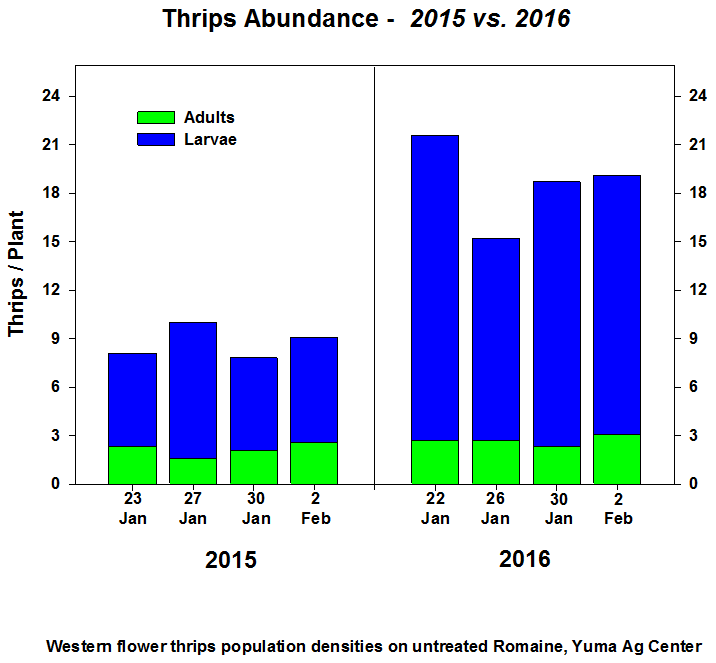
|
|
|
|

|
|||
|
|
|||
Thrips populations are slowly building in the Yuma Valley, and will likely continue to increase as the days grow longer and warmer. I expected that the rain we experienced in early January (0.75-1.0”) would reduce population numbers because heavy rainfall can dislodge or even drown adult thrips on plants, and can suffocate larvae in the soil. However, the recent rainfall did not appear to slow down thrips population development on untreated lettuce at the Yuma Ag Center. In fact, thrips larval numbers have been 2- times greater on untreated romaine as compared to this time last season (see graph below). It appears the rainfall had a negligible impact on these populations in the field; nor has the cooler weather we’ve experienced so far this winter. Based on historical data, if temperatures remain moderate and rainfall is light we can expect thrips numbers to reach very high levels by the end of the month. Note: the key to preventing thrips from significantly scarring leafy vegetable plants is to prevent immature populations from becoming established. The cryptic or thigmotactic bevahoir of thrips often makes them difficult to find on lettuce plants. Research has shown us that if you can see a few adults and larvae on the plant, it likely means that as many as 8-10 fold more thrips are actually on the plant (hiding near the base of the plant between midribs). This behavior also means that spray coverage is important, particularly with contact insecticides like Lannate, Torac and pyrethroids. For more information on the identification, biology, ecology and management of thrips on desert produce please visit Western Flower Thrips Management on Desert Produce. |
|||
| Back | |||
|
For questions or comments on any of the topics please contact Marco Pena at the Yuma Agricultural Center.
|
|||
|
Home |
Cotton | Veggies |
Forages | Grains
| Citrus |
Crop x Crop Insects | Diseases| Weeds | Pesticides | Economics | News | Weather | Research | Photos | Contacts | General Info. Copyright © 2001 University of Arizona, College of Agriculture and Life Sciences Webmaster: Al Fournier (acis@ag.arizona.edu) |
|||

